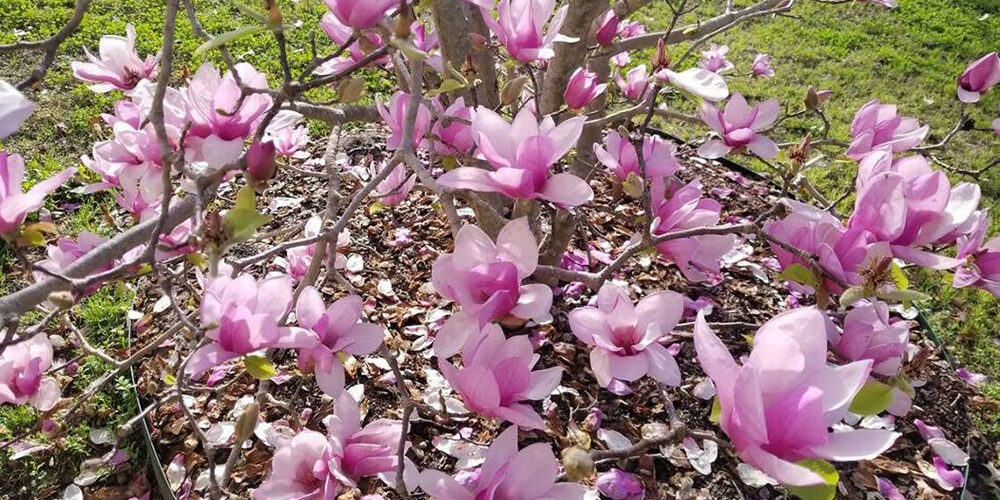Growing Saucer Magnolia

Saucer magnolia is a very popular flowering tree or large shrub that was originally created by cross-breeding Magnolia liliflora (lily magnolia, a shrub form) and M. denudata (lilytree). Originally bred by French cavalry officer Etienne Soulange-Bodin during the 1820s, this plant is still one of the most popular of all flowering trees in Europe and the U.S. It often grows as a multi-stemmed shrubby plant but can be trained into the form of a small tree. The huge early spring blooms appear before the leaves, but smaller numbers of flowers sometimes continue to bloom after the leaves emerge. The plant has a nicely rounded crown that makes it an ideal landscape specimen. The native species has pinkish-white flowers, but many cultivars are available with pure pink, magenta, and purple flowers.
Planting
How to grow saucer magnolias
Saucer magnolias are best planted in a full-sun to part-shade location—preferably not on southern exposures, since this can cause the flowers to open too early when cold early spring weather can damage the flowers. This tree doesn’t like extremely dry or wet soil, so try to give it rich soil that is both moist and well-draining. It also does best if somewhat protected from strong winds.
Care
Light
Saucer magnolia trees prefer full sun, but they can tolerate part shade locations.
Saucer magnolia trees do best in moist, acidic, organically rich and well-drained loamy soil, though they will tolerate clay soils.
During the first year of planting, water the tree deeply and frequently. Afterward, saucer magnolias need irrigation only when the weather is dry. Once established, these trees have a moderately good tolerance for drought.
Temperature and Humidity
Cool, rainy weather tends to cause fungal leaf spots and cankers on magnolia plants. If possible, avoid splashing soil from the ground onto the plants, and give them good air circulation.
Fertilizer
Magnolias are not heavy feeders, but they benefit from mixing fertilizer into the soil when planting, then lightly feeding them each spring with a balanced slow-release fertilizer. For annual spring feeding, do not mix the fertilizer into the soil, but rather spread it over the surface around the plant, then water it in.
Propagating Saucer Magnolia
Saucer magnolia is a fairly fast-growing tree that can be propagated from cuttings, but be prepared for a good number of the cuttings to fail. If you start 4 to 6 cuttings, you have a good likelihood of one or two succeeding. It’s best to take cuttings in summer after the buds have set.
- Use a sharp knife or pruning shears to cut a 6- to 9-inch cutting from the tip of a branch. Immediately place the cutting into water to keep it moist.
- Remove all but the upper leaves, then make a 2-inch vertical slice in the end of the stem.
- Dip the stem into a hormone solution, then place the tip of the cutting into a planter filled with moist perlite.
- Place the cutting in indirect light and cover it loosely with a plastic bag to keep the cutting humid. Mist the cutting often and watch for roots to grow.
- When a good network of roots has developed, the plant can be transferred to a larger pot filled with potting mix for continued growth. When vigorous upper growth has begun, the magnolia can be planted in the landscape.
Magnolias started this way often grow large enough to produce flowers within two years.
Recommended Varieties
- ‘Lennei Alba’ (M. x soulangiana ‘Lennei Alba’): This plant grows 15 to 20 feet high and wide with a broad, pyramidal form, making it ideal for small gardens. The flowers are globe-shaped and pure white; this tree flowers slightly later than the species.
- ‘Alexandrina’ (M. x soulangiana ‘Alexandrina’): This multi-stemmed variety grows 15 to 20 feet high. It is a cup-shaped plant with deep rose-purple flowers with white interiors.
- ‘Rustica Rubra’ (M. x soulangiana ‘Rustica Rubra’): This plant grows 15 to 25 feet high with a broad, open, pyramidal form. The flowers are rose-red.
- ‘Verbanica’ (M. x soulangiana ‘Verbannica’): This cultivar grows 20 to 25 feet high with an upright, broad, pyramidal form. The flowers, which appear later than other varieties, are cup-shaped and rosy-pink flowers with white interiors. Lustrous dark green leaves turn coppery brown in fall.
Website: www.thespurce.com